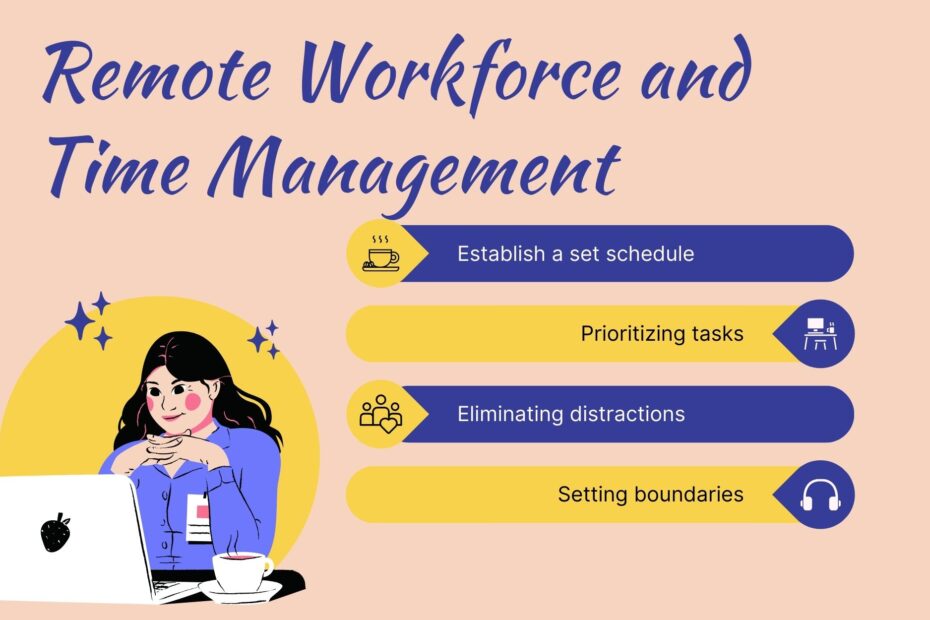The rise of remote work in recent years has led to an increase in the number of employees working from home or other remote locations. While working remotely can offer many benefits, such as increased flexibility and improved work-life balance, it can also present challenges when it comes to time management. Without the structure and boundaries of a traditional office environment, remote workers can easily get distracted or find themselves working longer hours than expected.
The purpose of this article is to explore time management strategies for remote workforces. By understanding the challenges of time management in a remote environment and implementing effective strategies, remote workers can increase their productivity and maintain a healthy work-life balance. Additionally, managers of remote teams can also benefit from these strategies to ensure the productivity and efficiency of their remote employees.
The Challenges of Time Management in Remote Workforce
Lack of structure and boundaries
One of the main challenges of remote worker time management is the lack of structure and boundaries. Without the physical presence of a traditional office environment, remote workers may find it more difficult to separate work and personal life, resulting in longer working hours and less time for rest and relaxation. This can lead to burnout and negatively impact employee well-being and productivity.
Distractions
Another challenge of remote worker time management is the possibility of distraction. Teleworkers may be more susceptible to interruptions from family members, roommates, and other distractions in the home environment. This can make it harder for remote workers to stay focused and complete tasks in a timely manner.
Disconnection
Additionally, remote work can lead to a sense of isolation and disconnection, which can make it harder for remote workers to stay motivated and engaged. This can lead to a lack of accountability and reduced productivity.
Lack of face-to-face interaction
Another challenge faced by remote workers is the lack of face-to-face interaction and communication, which can lead to misunderstandings and lack of coordination among team members. This can cause delays and errors that can negatively impact productivity.
Overall, a lack of structure, boundaries, and face-to-face interactions can make it harder for remote workers to manage their time effectively, and for managers to ensure the productivity and efficiency of their remote employees.
Time Management Strategies for Remote Workforce
Establish a set schedule
An effective strategy for managing time among remote workers is to establish a regular schedule. By setting specific times for work and non-work activities, remote workers can better manage their time and stay on track. This can include setting designated start and end times for the workday, as well as scheduling regular breaks and times for physical activity, rest and relaxation.
You may be interested to know: How To Create a Remote Work Schedule (Plus Template and Example)
Prioritize tasks
Another strategy for managing time among remote workers is prioritizing tasks. By focusing on the most important tasks first, remote workers can stay focused and ensure they are making the most of their time. This can include creating to-do lists, setting daily or weekly goals, and breaking down larger projects into smaller, manageable tasks.
Eliminating distractions
Eliminating distractions is also an important strategy for managing time for remote workers. Remote workers can do this by creating a dedicated workspace free from distractions, turning off notifications on electronic devices, and setting boundaries with family and roommates about when they work and when they don’t.
Setting boundaries
Setting boundaries is another key strategy for managing remote workforce time. This includes setting clear boundaries between work time and personal time, such as not checking work email or taking work calls outside of designated business hours.
Useful resources: 6 Ways to Set Healthy Boundaries at Work, Remotely
Effective communication and coordination
Finally, effective communication and coordination among team members can help ensure that remote workers complete tasks as planned and meet deadlines. This can include regular check-ins, scheduling team meetings and using collaboration tools to ensure all team members are aware of each other’s progress and can help each other out if needed. Useful articles: Top 8 Remote Collaboration Tools for Teams
Overall, by implementing effective time management strategies
Conclusion
In conclusion, managing time in a remote workforce can present challenges such as lack of structure and boundaries, potential for distraction, and feelings of isolation. However, by implementing effective time management strategies such as setting schedules, prioritizing tasks, eliminating distractions, setting boundaries, and effective communication and coordination among team members, remote workers can increase their productivity and stay healthy work-life balance.
Managers of remote teams can also benefit from these strategies by setting clear expectations and agreements, providing training and resources on time management, and creating opportunities for virtual team-building and networking events to keep remote workers productive and effective.
It’s important for companies to make employees aware of their remote work policies and expectations, and to provide clear guidelines and resources to help employees stay productive and engaged while working remotely.
Overall, remote work can have both positive and negative effects on time management. By understanding these impacts and taking steps to mitigate negative impacts, managers of remote workers and remote teams can make informed decisions about how best to support employees and maintain a positive company culture while working remotely.






